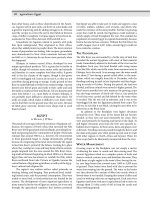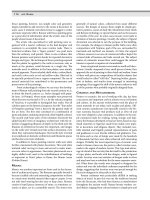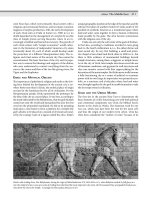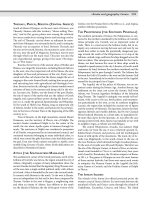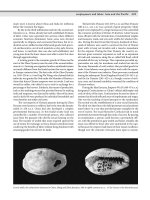Encyclopedia of society and culture in the ancient world ( PDFDrive ) 254
Bạn đang xem bản rút gọn của tài liệu. Xem và tải ngay bản đầy đủ của tài liệu tại đây (52.79 KB, 1 trang )
cities: Greece
built separately, though many large Greek cities had tenement blocks. The front entrance of the home faced south,
with a small entrance hall beyond which was an enclosed
central courtyard. Living rooms were at the back of the
home, arranged around a portico or courtyard; separate
servants’ quarters, kitchens, and reception halls were also
situated around the ground floor. Finer homes had bathrooms as well as second-story galleries over the porticoes,
where separate women’s quarters were located. City homes
were furnished with beds, chests, tables, chairs, carpets, and
tapestries and were provided with clay and metal drinking
vessels and storage jars. Walls were whitewashed and sometimes painted with geometric designs. The homes of the
wealthy displayed wall frescoes and mosaic floors.
NEW CITIES ABROAD
During the fift h century b.c.e. the polis of Athens reached the
height of its power and prosperity. About 40,000 citizens belonged to Athens, among a total population of about 300,000.
Sparta held far fewer citizens but included a large number of
serfs and slaves and a group of autonomous people who lived
in the city’s vicinity; altogether the Sparatan city-state included about 250,000 people.
As the cities of Greece grew, overpopulation prompted
overseas colonization. Greek colonists built new cities on the
coasts of the Black Sea, in Sicily, on the Adriatic Sea, in North
Africa, and Egypt. Greek town planning in Magna Graecia,
in modern-day southern Italy, had a strong influence on republican Rome. A Greek polis was first and foremost a body
of citizens, and if it moved overseas to a colony site, the colonists still identified themselves as members of a city. They
were dependent on their homelands for goods and trade, for
protection from coastal raids and pirates, and for the masons,
carpenters, and other tradesmen who could provide essential
services in the new territory.
The conquests of the Macedonian general Alexander
the Great (r. 336–323 b.c.e.) in the fourth century b.c.e.
spread Greek culture and cities into western Asia, from
Egypt to the Levant to Afghanistan. New Greek towns and
camps were raised where Alexander’s armies had passed,
and in defeated foreign capitals Greek temples, columns,
statuary, and public buildings appeared as monuments to
Greek civilization.
As his most enduring monument Alexander envisioned a
trading city on the Mediterranean shores of Egypt, at a sheltered point between Lake Mareotis and the island of Pharos.
After Alexander’s death in Babylon in 323 b.c.e. and under
King Ptolemy I (r. 323–285 b.c.e.), Dinocrates of Rhodes laid
out the city of Alexandria on the site of a small fishing village, Rhakotis. The new town had two main avenues, 200 feet
wide and lined with colonnades, running north-south and
east-west. The side streets crossed at right angles, in the Greek
fashion. The city had abundant fresh water drawn from Lake
Mareotis, as well as street gutters that drained into subterranean canals that lay underneath every street.
225
Alexandria prospered as the capital of Ptolemaic Egypt.
A flourishing center of Greek learning and culture, which
endured long after the conquest of Greece proper by the Romans, the city boasted impressive monuments, including the
tomb of Alexander, the lavish royal palaces of the Ptolemaic
kings, a monumental temple known as the Serapeion (also
spelled Serapeum), a museum, and the Library of Alexandria,
THE DECLINE OF THE CITY-STATE
Rivalries among the Greek cities worsened in the fifth
century B.C.E. as populations rose, trade routes grew
more crowded, and the Persian Empire threatened
invasion and conquest. The Peloponnesian War set
Athens and her allies against a federation led by Sparta, and it forced all other Greek cities to choose sides.
The war brought widespread death and destruction
and ended the dominance of Athens over the Greek
world. It prepared the Greeks for nationhood—and
for the end of the independent city-state.
In the semibarbarous northern realm of Macedon, the ambitious King Philip II (r. 359–336 B.C.E.) aspired to lord it over a weakened Athens and the entire
Greek world. He seized the gold and silver mines of
northern Greece and raised allies to work for his own
interests in all the major cities to the south. Thebes
allied with Athens to resist the Macedonians, but the
Greeks were soundly defeated at the Battle of Chaeronea in 338 B.C.E. Leading one wing of the Macedonian troops in this battle was Philip’s 17-year-old son,
the future Alexander the Great.
Chaeronea marked the end of Greek resistance
to Philip of Macedon. Soon after the battle, he organized the League of Corinth to fight the Persians,
who remained a constant threat. Each member of the
league was allowed to keep its own constitution, but
a national assembly began meeting at Corinth, and
Philip raised a new Greek army, under his personal
leadership, by levying troops from all the corners of
the Hellenic world.
Although Philip was assassinated in 336 B.C.E.,
his goal of uniting all the Greeks under a Macedonian
dynasty was realized by Alexander, a brilliant military tactician. Philip’s young heir traveled to Corinth,
where representatives from all the major Greek cities
hailed him as their nominal king. He took the reins of
the national army and, when the city of Thebes rebelled against him, besieged the city and burned it to
the ground. The traditional, independent city-state of
Greece, an institution dating back a millennium, grew
obsolete under Alexander’s reign and the subsequent
conquest of Greece by the Romans.
